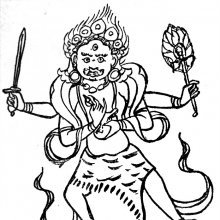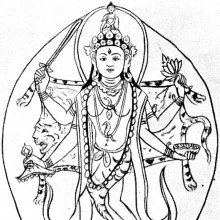Ugratara, Ugratārā, Ugra-tara: 6 definitions
Introduction:
Ugratara means something in Buddhism, Pali, Hinduism, Sanskrit. If you want to know the exact meaning, history, etymology or English translation of this term then check out the descriptions on this page. Add your comment or reference to a book if you want to contribute to this summary article.
Images (photo gallery)
In Hinduism
Shaktism (Shakta philosophy)
Source: Sacred Texts: Hymns to the GoddessUgratārā (उग्रतारा) is another name for Tara or Tāriṇī.—The Matsyasūkta, Tārārṇava, and Nīla Tantras deal with particulars or Tārā or Tāriṇī, one of the Mahāvidyā, whose bīja is Hrīm Strīm, Hūm (Kurccha), Phat. She is called Nīlasarasvatī, because She playfully gives the power of speech. She is called Tārā on account of her being deliverer or saviour (tārakatvāt). She gives both pleasure (sukha) and liberation (mokṣa). She is called also Ugratārā, because She saves from formidable and horrible calamities. Ṛṣi Vasiṣṭha [Vaśiṣṭha] is said to have cursed this vidyā, and then raised the curse so that siddhi might be gained from Her by japa of the Bīja Hrīm, Strīm, Hūm, Phat, after which She again became glorious.

Shakta (शाक्त, śākta) or Shaktism (śāktism) represents a tradition of Hinduism where the Goddess (Devi) is revered and worshipped. Shakta literature includes a range of scriptures, including various Agamas and Tantras, although its roots may be traced back to the Vedas.
In Buddhism
Tibetan Buddhism (Vajrayana or tantric Buddhism)
Source: archive.org: The Indian Buddhist IconographyUgratārā (उग्रतारा) is another name for Mahācīnatārā: one of the female emanations of Akṣobhya, as mentioned in the 5th-century Sādhanamālā (a collection of sādhana texts that contain detailed instructions for rituals).—Her Āsana is the pratyālīḍha; her Appearance is terrible; her Vāhana is the corpse; she has four arms.—Mahācīnatārā is also known in Buddhist Tantric literature as Ugratārā, and the Vajrayogini temple at Śāṅku in Nepal, contains in the sanctum a figure of Ugratārā. This Ugratārā or Mahācīnatārā of the Buddhists has been incorporated in the Hindu pantheon under the name of Tārā, and is now regarded as one of the ten Mahāvidyā goddesses.

Tibetan Buddhism includes schools such as Nyingma, Kadampa, Kagyu and Gelug. Their primary canon of literature is divided in two broad categories: The Kangyur, which consists of Buddha’s words, and the Tengyur, which includes commentaries from various sources. Esotericism and tantra techniques (vajrayāna) are collected indepently.
Languages of India and abroad
Sanskrit dictionary
Source: DDSA: The practical Sanskrit-English dictionaryUgratārā (उग्रतारा).—Name of a goddess.
Ugratārā is a Sanskrit compound consisting of the terms ugra and tārā (तारा).
Source: Cologne Digital Sanskrit Dictionaries: Monier-Williams Sanskrit-English DictionaryUgratārā (उग्रतारा):—[=ugra-tārā] [from ugra] f. Name of a goddess, [Kālikā-purāṇa]
[Sanskrit to German]
Sanskrit, also spelled संस्कृतम् (saṃskṛtam), is an ancient language of India commonly seen as the grandmother of the Indo-European language family (even English!). Closely allied with Prakrit and Pali, Sanskrit is more exhaustive in both grammar and terms and has the most extensive collection of literature in the world, greatly surpassing its sister-languages Greek and Latin.
See also (Relevant definitions)
Starts with: Ugratarakavaca, Ugratarapaddhati, Ugratarapancanga, Ugratarapujapaddhati, Ugratarasahasranaman, Ugratarastotra.
Full-text: Ugra, Gauhati, Ekajata, Uttaramnaya, Nilatantra, Tararnava, Tarini, Matsyasukta, Tararnavatantra, Tara, Nilasarasvati, Tarakatvat, Matsyasuktatantra, Mahacinatara.
Relevant text
Search found 6 books and stories containing Ugratara, Ugratārā, Ugra-tara, Ugra-tārā; (plurals include: Ugrataras, Ugratārās, taras, tārās). You can also click to the full overview containing English textual excerpts. Below are direct links for the most relevant articles:
The Indian Buddhist Iconography (by Benoytosh Bhattachacharyya)
Figure 135-136 - Emanations of Akṣobhya: Mahācīna Tārā (Ugratārā)
Varahi Tantra (English Study) (by Roberta Pamio)
Chapter 6 - Purṇābhiṣeka (full consecration) < [Summary of the Vārāhī Tantra]
Chapter 13 - Mantras and Yantras (mystical diagrams) < [Summary of the Vārāhī Tantra]
Chapter 22 - The the Six Āmnāyas < [Summary of the Vārāhī Tantra]
The Devi Bhagavata Purana (by Swami Vijñanananda)
Gati in Theory and Practice (by Dr. Sujatha Mohan)
Technical treatises on Nāṭya (other works) < [Chapter 1 - Nāṭya]
The gods of northern Buddhism (by Alice Getty)
Shakti and Shakta (by John Woodroffe)
Chapter VI - Śakti and Śākta < [Section 1 - Introductory]
Related products



